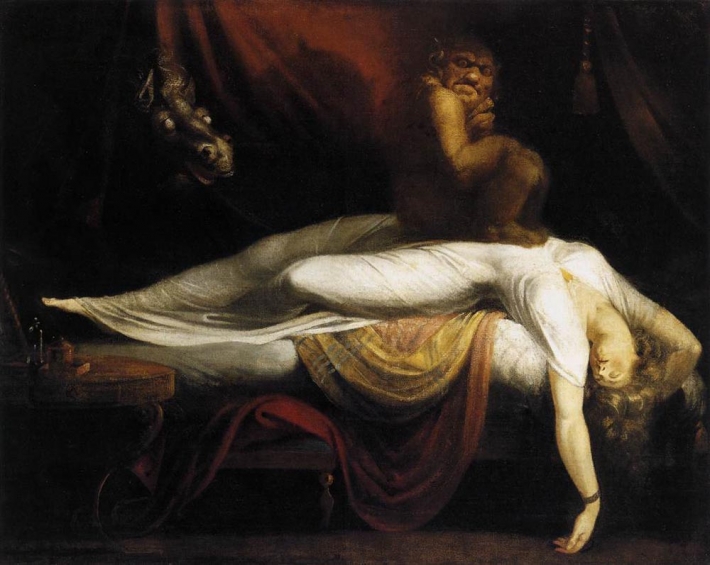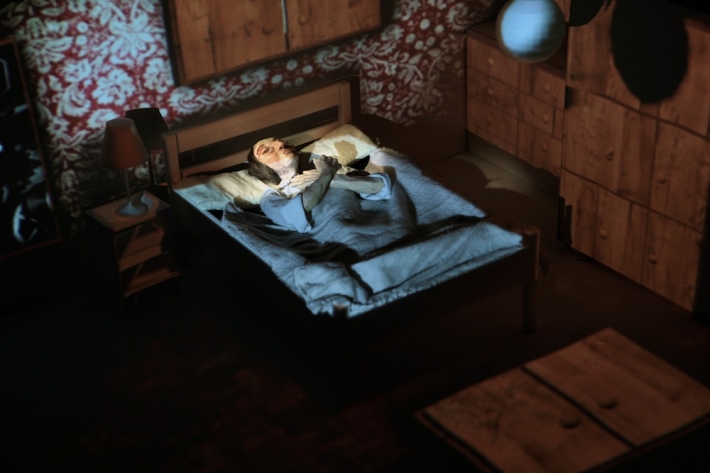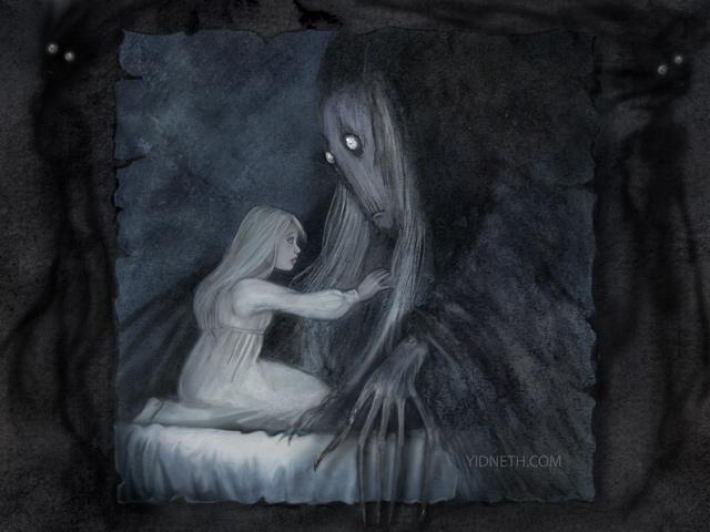Have you ever woken to find you're unable to move or call out, maybe with the feeling that there is someone else in the room? If so, you may have experienced a condition called 'Sleep Paralysis', a condition I was surprised to discover is actually quite common. At least half the population has experienced an episode of sleep paralysis at least once in their life. While experiencing sleep paralysis, people often find difficulty breathing and get the sense that they have a demon or ghost sitting on their chest. Connections have been made with perceived demon possession, alien abduction and out-of-body experiences, as instances of the phenomenon are so vivid they leave their subjects feeling like they've witnessed something supernatural.
Different cultures across the globe have they own myths and their own names for sleep paralysis. Most people will have heard of the condition, but possibly only by a folkloric name, for example, 'the Devil on your back' (African communities), Varypnas (Greece), or 'subirse el muerto' (dead person on you - Mexico). In Newfoundland, sleep paralysis is believed to be the result of a curse. A jealous person may cause their rival to be 'hagged' by saying the Lord's prayer backwards.
Joseph Herman has noted some mentions of sleep paralysis in literature, focusing on an episode in Herman Melville's 'Moby Dick'. He begins his essay on 'Sleep and Literature' by noting how many 'picturesque medical disorders' have often featured in literary works before being documented in scientific literature. Frequent readers of my blog will have noticed many examples that support this statement. In addition to medical disorders, there are a great number of unexplained phenomena that gained literary fame before facing the scrutiny of science. This has led to a significant body of myth and speculation.

John Henry Fuseli, 'The Nightmare' (1781)
Most experiences of sleep paralysis are associated with nightmarish visions, fruitful material for tales of horror and the supernatural. In fact, the etymology of the word 'Nightmare' shows its original coinage as a way of referring to sleep paralysis. The Old English word 'mare' refers to a mythological demon who torments humans while they sleep, inducing terrifying dreams. It therefore originally described not just bad dreams, but a perceived encounter with a demon in the middle of the night. Henry Fuseli's 'The Nightmare'(1781) is an iconic painting that has come to be associated with horror in general. The painting depicts a human in restless sleep with a demon sitting upon her chest, just as described in people's recollections of sleep paralysis.
The first description of sleep paralysis in scientific literature is a matter of great contention. There are appear to be accounts of sleep paralysis dating back to 400BC in a Chinese book of dreams and many descriptions given in Greek literature. In early history, the condition was often described as a 'nightmare' and with a lack of better explanation, was often cited as the result of poor diet or over-indulgence. A Dutch physician, Isbrand Van Diemerbroeck, produced a collection of case studies in the seventeenth century that would be of interest to anyone with an interest in sleep paralysis. Van Diemerbroeck notes the paralysis of the patients' muscles, except for their 'respiratory muscles', though his warnings show a lack of understanding, as he warns of 'Vapors':
This Malady is dangerous, least the collected Vapors being condensed in the Head, should breed a Coma, Apoplexy, or the like.
-- Van Diemerbroeck (1689)
An American neurologist, Silas Weir Mitchell, has often been cited as having described sleep paralysis for the first time in medical literature in 1876. It seems his title is highly contentious, but he did choose to rename the 'nightmare':
The subject awakes to consciousness of his environment but is incapable of moving a muscle; lying to all appearance still asleep. He is really engaged in a struggle for movement, fraught with acute mental distress; could he but manage to stir, the spell would vanish instantly.
-- Silas Weir Mitchell (1876)
Mitchell named the condition 'night palsy', as the subject undergoes head-to-toe immobility (except for the eyes) for a period of time usually between 30 seconds and 5 minutes. It occurs most often when the person is waking up and less often when falling asleep. Mitchell notes the 'acute mental distress' which grips the sufferer, when they realise they're unable to move and often have trouble breathing. The word 'spell' is aptly named as the sufferer is likely to feel like they are being controlled by supernatural forces beyond their control. Often people try to make sense of their situation by imagining demons and other-worldly creatures. In Mitchell's time, whatever was causing 'night palsy' was still a mystery and certainly appeared to be a 'spell', or more accurately, a curse.

Carla MacKinnon, 'Devil In The Room' (2013)
Now we know that sleep paralysis is the result of miscommunication between different parts of the brain that control the body's physiology while it is asleep. The actual paralysis is a normal part of REM (Rapid Eye Movement) sleep, and is referred to as REM antonia. The pons (the part of your brain in control of heart rate and breathing) sends messages to the spinal cord, which produces chemicals to paralyse the muscles during sleep. This is to ensure the body can't move too much while unconscious and potentially injure itself. However, sometimes the person can become aware of this paralysis during the process of falling asleep or waking up.
Sleep paralysis is also more likely to occur to people who sleep in a supine position, on their back. This is because the airways in the throat can occasionally collapse while sleeping on your back, which can deprive your lungs of oxygen momentarily. In non-paralysing, non-dream sleep, it is easy to move and resolve this. However, while in REM dream sleep, the brain must stop the production of these paralysing chemicals to allow the body to move. For some reason, this doesn't always happen, so the person can become conscious and aware of their surroundings but will be unable to move. They are likely to sense that they have difficulty breathing. The amygdala part of the brain is alerted, responsible for the fight-or-flight command, so the subject becomes panicked. The brain is remarkably adept at providing explanations for the body's current situation, so it conjures images of demons and aliens, often sitting on the subject's chest to prevent them breathing. Of course, this turns the incident into a nightmarish experience.
It is therefore unsurprising that sleep paralysis has inspired many pieces of literature, especially stories with fantasy and horror elements. Guy de Maupassant's 'The Horla' tells the tale of a man plagued by sleep paralysis, though because it is a tale of horror, the supernatural being is real and the haunting relentless. The tale has been cited as inspiration for Lovecraft's 'Call of Cthulu', as both feature an extraterrestrial who has an influence over human minds. 'The Horla' is a supernatural being who is invited, inadvertently, to haunt the narrator's home. The narrator begins to experience insomnia, waking every night to the feeling that he is being watched and that someone is kneeling on his chest. He begins to develop a fever, as the dread of going to sleep and encountering the demon begins to permeate his everyday thoughts. His gradual loss of sanity is extreme in the tale, but shows how sufferers of the condition, to whom the visions seem very vivid and real, can find their everyday life affected.
Then, I go to bed, and I wait for sleep as a man might wait for the executioner. I wait for its coming with dread, and my heart beats and my legs tremble, while my whole body shivers beneath the warmth of the bedclothes, until the moment when I suddenly fall asleep, as a man throws himself into a pool of stagnant water in order to drown. I do not feel this perfidious sleep coming over me as I used to, but a sleep which is close to me and watching me, which is going to seize me by the head, to close my eyes and annihilate me.
I sleep - a long time - two or three hours perhaps - then a dream - no - a nightmare lays hold on me. I feel that I am in bed and asleep - I feel it and I know it - and I feel also that somebody is coming close to me, is looking at me, touching me, is getting on to my bed, is kneeling on my chest, is taking my neck between his hands and squeezing it - squeezing it with all his might in order to strangle me.
I struggle, bound by that terrible powerlessness which paralyzes us in our dreams; I try to cry out - but I cannot; I want to move - I cannot; I try, with the most violent efforts and out of breath, to turn over and throw off this being which is crushing and suffocating me - I cannot!
-- Guy de Maupassant, 'The Horla' (1887)

Priscilla Hernández, 'Nightmare'
However, as real and terrifying as it might seem at the time, sleep paralysis is not caused by the interference of supernatural creatures. It can be a symptom of narcolepsy, in which case, it is accompanied by a number of of other sleep-related symptoms. More often, it is induced by an irregular sleep schedule or periods of sleep deprivation, stress or illness. Napping throughout the day and sleeping in can also cause the condition. Sleep paralysis most often occurs in teenagers and its rare for a first attack to happen after the age of twenty five, which is probably good news for the majority of my readers. It has also been suggested that a person's state of mind can affect the prevalence of sleep paralysis, as it can be induced more often by a fear of death or a belief in controlling fates.
Literature has proved to be often accurate in documenting the experience of sleep paralysis and the factors that contribute to its occurrence. One well-known episode of sleep paralysis in literature is that experienced by the young Ishmael in Herman Melville's 'Moby Dick', when he is sent to bed in the middle of the afternoon by his stepmother:
... and slowly waking from it - half steeped in dreams - I opened my eyes and the before sunlit room was now wrapped in outer darkness. Instantly I felt a shock running through all my frame; nothing was to be seen and nothing was to be heard; but a supernatural hand seemed placed in mine. My arm hung over the counterpane, and the nameless, unimaginable silent form or phantom, to which the hand belonged, seemed closely seated by my bedside. For what seemed ages piled on ages, I lay there, frozen with the most awful fears, not daring to drag away my hand; yet ever thinking that if I could but stir it one single inch, the horrid spell would be broken.
-- Ishmael, Herman Melville, 'Moby Dick' (1851)
Melville documents Ishmael's state of mind in the lead up to his sleep paralysis, after he is sent to bed for misbehaving. There is reference made to the 'small of his back' aching, which suggests he was perhaps sleeping in the supine position. His room is very light and he can hear the 'rattling of coaches in the streets' and 'gay voices all over the house'. His lack of tiredness, alongside all these sounds that could disturb his sleep, seem to be the perfect conditions for an episode of sleep paralysis.
However, there are a small percentage of people for whom sleep paralysis is not necessarily a terrifying experience. Sufferers can learn how to recognise when they're entering an episode of sleep paralysis, so they can be aware that the experience is just in their imagination and that they will soon come out of it. This helps to keep them calm and reduces the number of terrifying visions. Some even look forward to the experience because it allows them to enter a state of lucid dreaming. During these times, they are able to explore parts of their subconscious, as they are aware that what they're experiencing is a dream and they are even able to control the content. This skill seems to be an empowering way of turning an unpleasant experience into one that is enjoyable. This can have a positive impact on the everyday life of someone who experiences sleep paralysis, as instead of fearing going to sleep at night, they can look forward to it.
If you're interested in finding out more about sleep paralysis, I recommend Carla MacKinnon's short film on the condition, 'Devil in the Room', which has been accoladed with numerous awards over the past year. It's brilliant, but be warned, it's very creepy.
References & Further Reading
- Maupassant, 'The Horla' (1887).
- Melville, 'Moby-Dick', Richard Bentley (1851).
- Cardin, 'Nexus Of Nightmares: Fuseli, Sleep Paralysis, and Horror's Master Image,' Guest Post On Dream Studies Portal (2012).
- Herman, 'Literature And Sleep: An Instance Of Sleep Paralysis In Moby Dick', Sleep Journal, 20(7):577-579.
- Kompanje, ''The Devil Lay Upon Her And Held Her Down', Hypnagogic Hallucinations And Sleep Paralysis Described By The Dutch Physician Isbrand Van Diemerbroeck (1609-1674) In 1664', Journal Of Sleep Research (2008).
- Schenck, 'Sleep: A Groundbreaking Guide To The Mysteries, The Problems, And The Solutions', Penguin (2007).
- The Sleep Paralysis Project and MacKinnon's 'Devil In The Room'.
Listing image: Nile Can Too / DeviantArt
